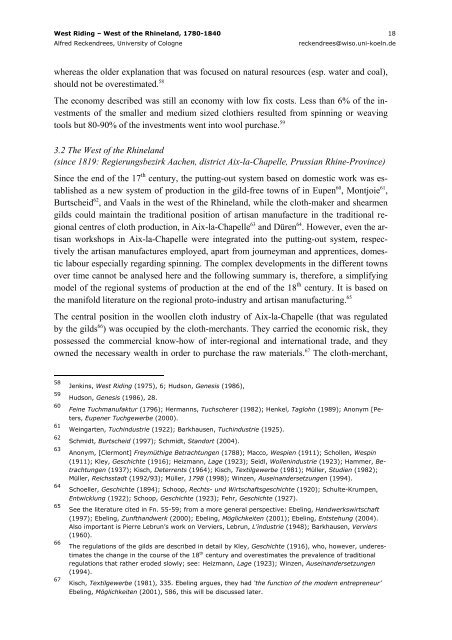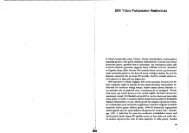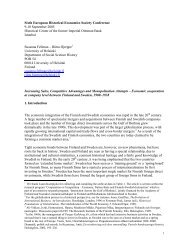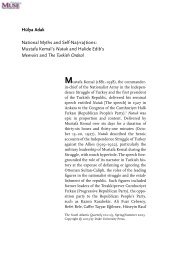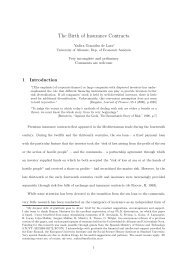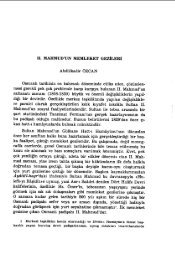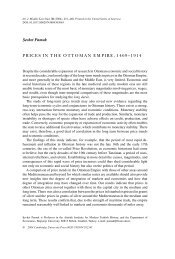West Riding – Western Rhineprovince, 1790-1840: Diverse Paths to ...
West Riding – Western Rhineprovince, 1790-1840: Diverse Paths to ...
West Riding – Western Rhineprovince, 1790-1840: Diverse Paths to ...
You also want an ePaper? Increase the reach of your titles
YUMPU automatically turns print PDFs into web optimized ePapers that Google loves.
<strong>West</strong> <strong>Riding</strong> <strong>–</strong> <strong>West</strong> of the Rhineland, 1780-<strong>1840</strong> 18<br />
Alfred Reckendrees, University of Cologne reckendrees@wiso.uni-koeln.de<br />
whereas the older explanation that was focused on natural resources (esp. water and coal),<br />
should not be overestimated. 58<br />
The economy described was still an economy with low fix costs. Less than 6% of the investments<br />
of the smaller and medium sized clothiers resulted from spinning or weaving<br />
<strong>to</strong>ols but 80-90% of the investments went in<strong>to</strong> wool purchase. 59<br />
3.2 The <strong>West</strong> of the Rhineland<br />
(since 1819: Regierungsbezirk Aachen, district Aix-la-Chapelle, Prussian Rhine-Province)<br />
Since the end of the 17 th century, the putting-out system based on domestic work was established<br />
as a new system of production in the gild-free <strong>to</strong>wns of in Eupen 60 , Montjoie 61 ,<br />
Burtscheid 62 , and Vaals in the west of the Rhineland, while the cloth-maker and shearmen<br />
gilds could maintain the traditional position of artisan manufacture in the traditional regional<br />
centres of cloth production, in Aix-la-Chapelle 63 and Düren 64 . However, even the artisan<br />
workshops in Aix-la-Chapelle were integrated in<strong>to</strong> the putting-out system, respectively<br />
the artisan manufactures employed, apart from journeyman and apprentices, domestic<br />
labour especially regarding spinning. The complex developments in the different <strong>to</strong>wns<br />
over time cannot be analysed here and the following summary is, therefore, a simplifying<br />
model of the regional systems of production at the end of the 18 th century. It is based on<br />
the manifold literature on the regional pro<strong>to</strong>-industry and artisan manufacturing. 65<br />
The central position in the woollen cloth industry of Aix-la-Chapelle (that was regulated<br />
by the gilds 66 ) was occupied by the cloth-merchants. They carried the economic risk, they<br />
possessed the commercial know-how of inter-regional and international trade, and they<br />
owned the necessary wealth in order <strong>to</strong> purchase the raw materials. 67 The cloth-merchant,<br />
58<br />
Jenkins, <strong>West</strong> <strong>Riding</strong> (1975), 6; Hudson, Genesis (1986),<br />
59<br />
Hudson, Genesis (1986), 28.<br />
60<br />
Feine Tuchmanufaktur (1796); Hermanns, Tuchscherer (1982); Henkel, Taglohn (1989); Anonym [Peters,<br />
Eupener Tuchgewerbe (2000).<br />
61<br />
Weingarten, Tuchindustrie (1922); Barkhausen, Tuchindustrie (1925).<br />
62<br />
Schmidt, Burtscheid (1997); Schmidt, Standort (2004).<br />
63<br />
Anonym, [Clermont] Freymüthige Betrachtungen (1788); Macco, Wespien (1911); Schollen, Wespin<br />
(1911); Kley, Geschichte (1916); Heizmann, Lage (1923); Seidl, Wollenindustrie (1923); Hammer, Betrachtungen<br />
(1937); Kisch, Deterrents (1964); Kisch, Textilgewerbe (1981); Müller, Studien (1982);<br />
Müller, Reichsstadt (1992/93); Müller, 1798 (1998); Winzen, Auseinandersetzungen (1994).<br />
64<br />
Schoeller, Geschichte (1894); Schoop, Rechts- und Wirtschaftsgeschichte (1920); Schulte-Krumpen,<br />
Entwicklung (1922); Schoop, Geschichte (1923); Fehr, Geschichte (1927).<br />
65<br />
See the literature cited in Fn. 55-59; from a more general perspective: Ebeling, Handwerkswirtschaft<br />
(1997); Ebeling, Zunfthandwerk (2000); Ebeling, Möglichkeiten (2001); Ebeling, Entstehung (2004).<br />
Also important is Pierre Lebrun’s work on Verviers, Lebrun, L'industrie (1948); Barkhausen, Verviers<br />
(1960).<br />
66<br />
The regulations of the gilds are described in detail by Kley, Geschichte (1916), who, however, underestimates<br />
the change in the course of the 18 th century and overestimates the prevalence of traditional<br />
regulations that rather eroded slowly; see: Heizmann, Lage (1923); Winzen, Auseinandersetzungen<br />
(1994).<br />
67<br />
Kisch, Textilgewerbe (1981), 335. Ebeling argues, they had ‘the function of the modern entrepreneur’<br />
Ebeling, Möglichkeiten (2001), 586, this will be discussed later.


